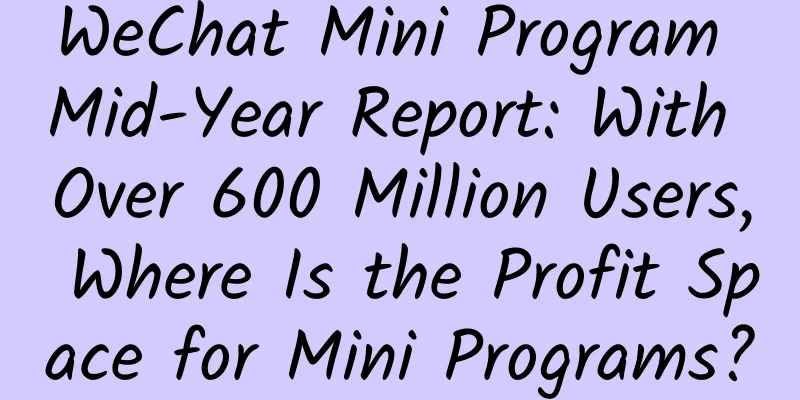WeChat Mini Program Mid-Year Report: With Over 600 Million Users, Where Is the Profit Space for Mini Programs?

|
1 million Mini Programs have been released, 1.5 million developers, 2,000 mini games... 16 months after its launch, Mini Programs have entered the rapid development 2.0 era. The entry of Baidu in July has accelerated the formation of a situation where there is one super Mini Program and many strong Mini Programs. The Mini Program ecosystem is extremely prosperous, and the mobile Internet may be facing a reshuffle. Recently, Jisu App released a "2018 Mini Program Ecosystem Evolution Report", which conducted an in-depth analysis of the current status of mini programs from four dimensions: mini program ecosystem changes, advanced user behavior analysis, hot industry market performance, and third-party development service provider development, and speculated on the future development trend of mini programs. 1. The total number of mini programs reached 1 million, with second- and third-tier cities accounting for nearly half in Q2 2018 The total number reached 1 million, a 72% increase from the 580,000 mini programs six months ago, and the mini program market size showed a rapid expansion trend. From the perspective of geographical distribution, mini programs are mainly concentrated in first-, second-, and third-tier cities, of which second- and third-tier cities accounted for 46.3%, nearly half. First-tier cities have a more mature mini-program incubation environment and have a greater advantage in the early stages of market development. However, as the mini-program ecosystem expands, the construction of various offline service scenarios in second- and third-tier cities has begun to enter a period of rapid development. The mini-program market has huge demand, attracting a large number of developers to continue to pour in. 2. The cumulative number of mini-program users exceeded 600 million, thanks to mini-games and the 618 e-commerce festival The viral spread of various popular mini-games in April this year, as well as the promotion of mini-programs by merchants during the 618 e-commerce festival, led to a large-scale growth in the number of mini-program users. By June this year, the total number of mini-program users had exceeded 600 million. The report shows that the stickiness of mini-program users has also increased significantly. Nearly half of users open mini-programs 4-6 times a day, and the average single usage time has reached 13 minutes. Influenced by mini-games, the time users spend immersed in mini-programs has increased significantly. The continuous strengthening of important entrances such as sharing, public accounts, and drop-down taskbars has brought huge traffic to the mini program. After a year and a half, the mini program users have developed usage habits and their spending power is also increasing rapidly. 3. Mini Programs’ revenue in June increased by 35% month-on-month, with rapid penetration into scenarios As the offline scenario that mini programs have always focused on, the traffic of smart retail mini programs has grown steadily as a whole, with the largest month-on-month growth rate reaching 55%. The high-frequency and even rigid-demand services brought by the ubiquitous smart retail consumption scenarios have stimulated users to continue to consume. Therefore, traffic conversion has also maintained a steady growth, with a month-on-month increase of 35% in June. With the deep integration of smart retail mini-programs with stores, official accounts, WeChat payments, and social sharing, the core elements of retail scenarios, “people, goods, venues, and services”, have been intelligently connected, greatly improving the operational efficiency of merchants and satisfying the consumption needs of users. 4. Traffic increased 60 times, maintaining its leading position The marketing and traffic diversion value of e-commerce mini programs in the WeChat system is particularly prominent, and they have become an important way for merchants to create momentum and marketing during e-commerce festivals such as Double Eleven and 618. During this period, the user traffic of various e-commerce mini programs showed explosive growth. Among them, the growth rate of fashion e-commerce mini programs was the fastest, with a cumulative traffic growth of 60 times compared to Q1 2017. Cross-border e-commerce also performed well, with traffic showing steady growth since 2017, and in Q2 2018, it developed into the second largest category after fashion e-commerce. The two main forms of e-commerce mini programs are content e-commerce and social e-commerce, which combine WeChat public accounts and social relationship chains to establish direct connections between brands and customers and form word-of-mouth effects. The gradual opening of direct service and brand zones will also push e-commerce mini programs to the next explosion point. 5. The catering industry performed outstandingly in offline service mini programs, with revenue growth reaching 85% month-on-month Scanning QR codes offline integrates offline scenarios with online instant services, effectively shortening service time and allowing offline traditional stores to extend services to mini programs. At the same time, the convenient "use it now and go" service experience of mini programs is deeply loved by users. In the second quarter of 2018, the traffic of various offline service mini programs such as catering, beauty, leisure and entertainment, tourism, and government affairs surged, among which the traffic of leisure and entertainment mini programs increased by 143% month-on-month. Functions such as scanning QR codes to order food have opened up all aspects of catering consumption, quickly improving the operating efficiency and order conversion rate of catering stores. In Q2 2018, the turnover growth reached 85% month-on-month, which is in a stage of rapid development. The main purpose of offline service mini-programs is to guide offline users to online traffic pools for storage. Merchants who focus on upgrading user service experience and building membership systems will gain greater advantages. 6. Third-party platforms enter the plug-in market to adapt to new needs of developers Third-party service providers represented by the mini-program development tool Jisu App play an important role in the development of the mini-program market. Among the 110,000 mini-programs launched through Jisu App platform, most are in the e-commerce, smart retail, and catering industries, while also covering chain stores, content industry, beauty industry, leisure and entertainment and other industries. Among them, e-commerce mini-programs account for nearly 30%, accounting for ***. In addition, according to the background of Jisu App, overseas Mini Program developers account for 1.4%, of which Europe and Russia account for a relatively high proportion. As a new type of lightweight application, Mini Programs have been used in various countries and regions around the world. The overseas Mini Program market may become the next development direction that developers pay close attention to. The three mini-program production modes and plug-in platform provided by Jisu App are suitable for developers at different levels to a great extent. Mini-program developers in the e-commerce and offline store industries who need to frequently use various marketing tools such as membership cards and coupons can greatly improve their development and operation efficiency. 7. The second half of 2018 is a critical period for the evolution of the mini program ecosystem The 2018 Mini Program New Ecosystem Summit held in Shenzhen on August 4 will provide a more in-depth interpretation of the current status and future development of the Mini Program ecosystem based on the 2018 Mini Program Ecosystem Evolution Report. It can be predicted that in the second half of 2018, Mini Programs will enter a new ecological evolution stage, showing the following development trends: Mini Programs are deployed on tablets and PCs, and the entrance to Tencent products is fully open Mini programs will soon be available on tablets, and may also be available on PCs in the future. Mini program portals will no longer be limited to WeChat, but will gradually extend to platforms other than WeChat. Various portals for Tencent products will gradually be fully open to mini programs. Mini-program development model is developing towards plug-in More and more developers will tend to quickly develop mini programs through plug-ins. The plug-in-based mini program development model will greatly reduce the technical threshold and increase the diversity of mini program functions. Mini Program scenarios and entry upgrades focus more on improving retention As functions such as group dynamic messages, subscription messages, and brand category searches are gradually opened up, mini program operators will have more channels to establish deeper connections with users, greatly improving retention rates. More vertical segments emerge in mini program e-commerce With the popularization of social e-commerce models, the vertical segments of e-commerce mini-programs will continue to expand, the user base of cross-border e-commerce, digital e-commerce, fresh food e-commerce and agricultural trade e-commerce will continue to rise, and more segmented operating models will be explored. Mini Programs will become the standard for the smart retail industry Mini programs help retailers connect online and offline scenarios, forming an integrated linkage operation model of "mini programs + official accounts + stores". This refined digital operation model will also become the standard for the smart retail industry. The monetization model is diversified, with advertising components and virtual payment becoming the focus. The mini program advertising system will become more diversified, virtual payment may be fully reopened, and content, tool mini programs and mini games can realize more monetization models. At present, the mini program market is in a period of rapid development. Under the leadership of WeChat, giants such as Alipay, Quick App Alliance, and Baidu have joined the battle. It is expected that all the top apps will enter the market in 2019, and mini programs will become a cross-platform species. In 2021, the mini program market will enter a stable and mature period, comparable to the entire mobile Internet market. By then, mini programs will no longer be light application products attached to WeChat, but the lifeblood of guiding the development direction of the Internet ecosystem. |
<<: Not all apps on Google Play are safe: 10 apps contain Trojans
>>: Why Google was fined a record 4.3 billion euros by the European Union
Recommend
The official version of iOS 17.0.3 is released, and the heating problem is finally solved!
iOS 17.0.3 official version released This morning...
Why are buildings made into "potato chips"? Not to tempt you, but because they are strong...
01 Potato Chips. What shape are you? In fact, the...
If I give you four chances to travel through time, would you dare to have a blood transfusion?
Should I take this risk or that risk? Compilation...
Takata incident continues, AQSIQ summons Volkswagen, GM, and Mercedes-Benz
Yesterday, the Law Enforcement Supervision Depart...
9 methods for selecting topics for short video operations, super comprehensive!
In short video creation, topic selection means th...
Does increasing the volume of information flow advertising really require piling up a large number of accounts and plans?
In the information flow advertising industry, who...
What is the difference between a 20 yuan shampoo and a 200 yuan shampoo?
People often complain: Why do I spend money on a ...
These gadgets can make your Android phone more useful
Many people say that Android is not as good as iPh...
Xiaohongshu Hot Item Guide: The Secret to Achieving One Million in Monthly Sales from 0 in 3 Months!
As of May 2019, the number of registered users on...
Advertising script and running volume formula!
Why does the original material cost hundreds of t...
Three reasons led to a collective change of management at PPTV
Yesterday afternoon, the industry reported that P...
Payment APP rankings for March 2020 are freshly released
Recently, Analysys released a new APP index. Acco...
If I punch in on time when the leap second arrives, will it be shown as late for work?
January 1, 2017 can be regarded as a New Year wit...









